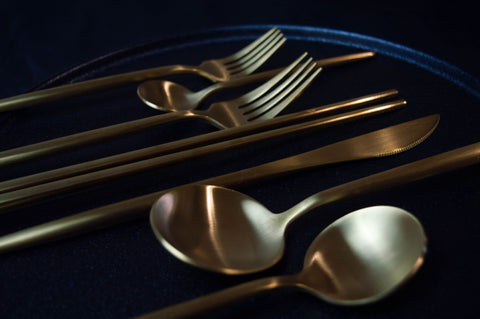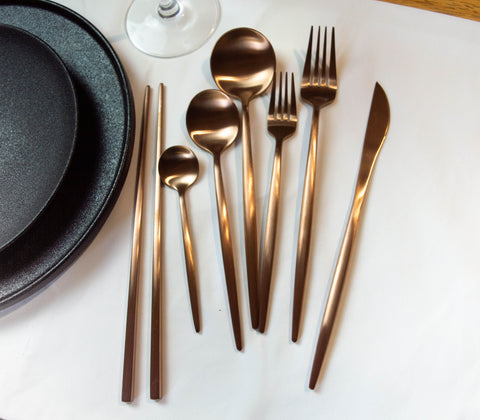"Have you ever wondered how professional chefs keep their cutlery looking immaculate? No matter how hard we try, our knives and forks can't achieve that same brilliant shine. Well, fret no more because I have an exciting secret: vinegar might just be the missing ingredient in your quest for sparkling silverware! Does vinegar make cutlery shine?
In this article, we will delve into the mysteries of vinegar's cleaning properties and uncover whether it truly lives up to its reputation as a miracle worker in restoring the luster of our beloved utensils. Prepare yourself for some eye-opening revelations!"
The Role of Vinegar in Cleaning Cutlery
Vinegar plays a crucial role in cleaning cutlery due to its acidic properties. It acts as a mild acid that can help dissolve mineral deposits, tarnishes, and other residues that accumulate on cutlery over time. This acidity makes it effective in restoring the shine and luster of silverware and other metal utensils. When combined with proper cleaning techniques, vinegar can be a valuable tool for keeping your cutlery in pristine condition.
Benefits of Using Vinegar for Shining Cutlery
Using vinegar for shining cutlery offers several benefits:
Natural and Non-Toxic:
Vinegar is a natural and non-toxic cleaning agent, making it a safe option for cleaning and polishing cutlery. It doesn't introduce harmful chemicals into your kitchen or food preparation areas.
----> Check out Amazon! KiiZYs' Flatware Set and Serveware Set are Lead free, Cadnium free and Phthalates free.
Effective Stain Removal:
Vinegar's acidity makes it highly effective at removing stains, tarnishes, and mineral deposits from cutlery, leaving your utensils looking clean and polished.
Economical:
Vinegar is an affordable cleaning solution, which can save you money compared to purchasing specialized cleaning products for cutlery.
Versatility:
Vinegar can be used for various cleaning tasks in the kitchen, making it a versatile household item. It's not limited to cutlery and can be employed in cleaning other kitchen appliances and surfaces.
Environmentally Friendly:
Using vinegar reduces the need for harsh chemicals, contributing to a more environmentally friendly cleaning routine.
Less Abrasive:
Compared to some commercial cleaning products, vinegar is less abrasive on metal surfaces, reducing the risk of scratching or damaging your cutlery.
Quick and Easy:
The process of shining cutlery with vinegar is straightforward and requires minimal effort, making it a convenient choice for maintaining your kitchen tools.

Steps to shine Cutlery with Vinegar
Vinegar may be commonly known for its culinary uses, but it can also be an impressive helper for cleaning and shining cutlery. If you're tired of spending money on expensive silver polish or chemical cleaners, vinegar might become your new best friend. Follow these simple steps to restore the shine to your dull and tarnished cutlery.
Gather Your Supplies:
-
White vinegar
-
Water
-
Soft, lint-free cloths or paper towels
-
A small bowl or container
-
Your tarnished or dull cutlery
Prepare a Vinegar Solution:
Mix equal parts of white vinegar and water in a small bowl or container. This diluted solution is less likely to damage your cutlery while effectively cleaning and shining it.
Soak the Cutlery:Place the tarnished or dull cutlery into the vinegar solution. Ensure the cutlery is fully submerged.
Let It Soak:
Allow the cutlery to soak for 5-10 minutes. This soaking period helps the vinegar solution break down tarnish and mineral deposits.
Scrub Gently:
After soaking, use a soft cloth or paper towel to scrub the cutlery gently. Pay special attention to areas with visible stains or tarnishes.
Rinse and Dry:
Rinse the cutlery with water to remove any remaining vinegar residue. Dry the cutlery thoroughly with a clean cloth to prevent water spots.
Polish the Cutlery:
If your cutlery isn't as shiny as you'd like, you can further polish it using a clean, dry, or specialized metal polishing cloth. Buff the cutlery until it shines to your satisfaction.
Inspect and Repeat (if necessary):
Inspect the cutlery to ensure it meets your desired level of shine. If some areas still appear tarnished, you can repeat the process.

Other Alternatives for Shiny Cutlery
If you're looking for alternatives to vinegar for achieving shiny cutlery, several options are available, each with its unique cleaning and polishing approach. Here are a few alternatives:
1. Baking Soda:
Baking soda is a gentle abrasive that can help remove stains and tarnishes from cutlery. Create a paste by mixing baking soda with a small amount of water and use it to scrub your utensils. Rinse and dry thoroughly for a shiny finish.
2. Lemon Juice:
Lemon juice is naturally acidic and can help break down tarnishes and stains on cutlery. You can rub cutlery with a lemon wedge or paste with lemon juice and salt, then use it to clean your utensils.
3. Commercial Metal Polish:
Specific metal polishes, such as Hagerty Silversmiths' Polish or Wright's Silver Cream, are designed for cutlery. These products are formulated to remove tarnish and restore shine.
4. Aluminum Foil and Baking Soda:
Line a bowl with aluminum foil, add hot water, and mix in baking soda. Place your tarnished cutlery in the solution, and the tarnish will transfer to the aluminum foil. Rinse and dry for a polished look.
5. Toothpaste:
Non-gel, non-whitening toothpaste can be used to scrub gently and polish cutlery. Apply a small amount to a soft cloth or sponge, then rub it onto the utensils and rinse thoroughly.
6. Club Soda:
The carbonation in club soda can help break down stains and loosen debris on cutlery. Soak the cutlery in club soda briefly, then scrub and rinse.
7. Commercial Silver Dips:
Various commercial silver dips are available that can quickly remove tarnish from silver cutlery. Follow the product instructions carefully.
Final Thoughts
In conclusion, vinegar can indeed make cutlery shine. Its acidic properties help to remove tarnish and stains from metal surfaces, resulting in a polished and lustrous finish. Vinegar can effectively restore their shine, whether it is silverware, stainless steel knives, or brass utensils.
However, it is important to note that vinegar should be used cautiously on certain materials, such as gold-plated or aluminum cutlery, as it may cause damage. To get the best results, diluting vinegar with water and using a soft cloth for gentle cleaning is recommended. So next time your cutlery needs some extra sparkle, try vinegar!
KiiZYs kitchenware are FDA approved: Matching Serveware and Silverware Set
FAQs
Q: Does vinegar damage stainless steel?
A: No, vinegar does not damage stainless steel when used for cleaning purposes.
Q: How often should I clean my cutlery with vinegar?
A: It depends on how frequently you use your cutlery and how quickly they get tarnished. As a general guideline, cleaning them every 1-2 months should suffice.
Q: Will using vinegar remove scratches from my cutlery?
A: Vinegar may help reduce the appearance of minor scratches but won't completely eliminate deep marks or dents.

